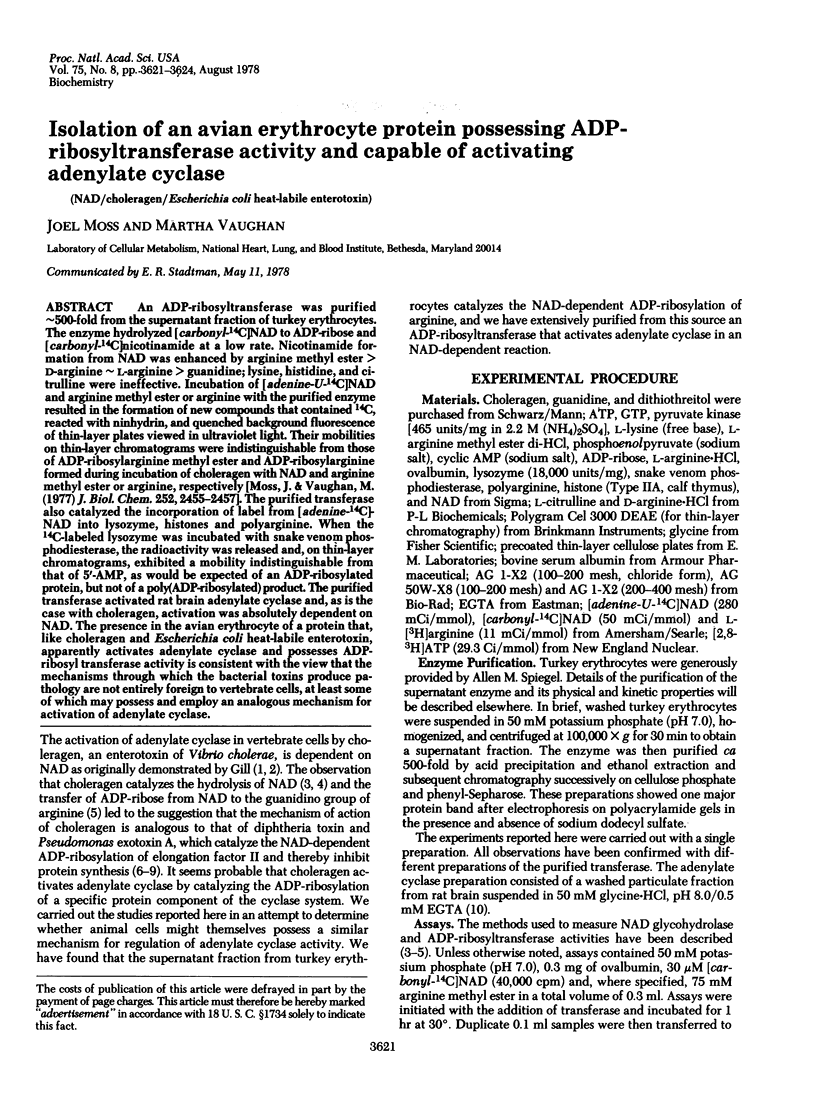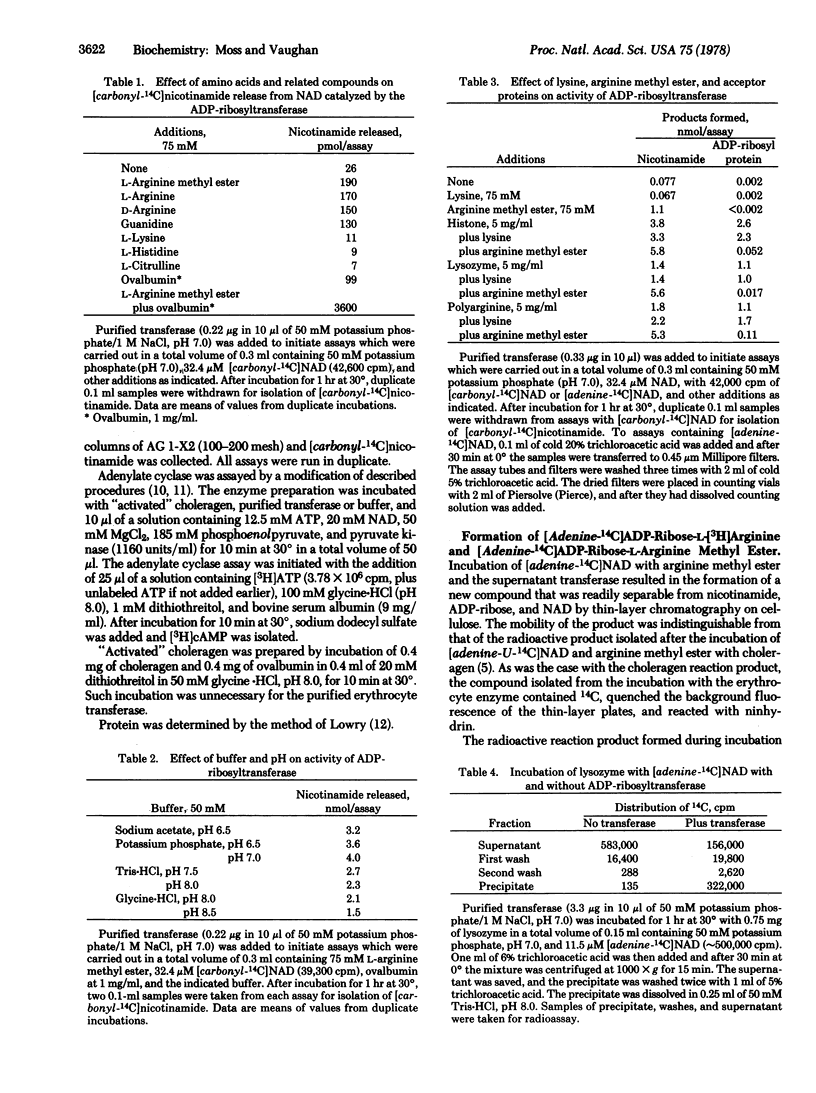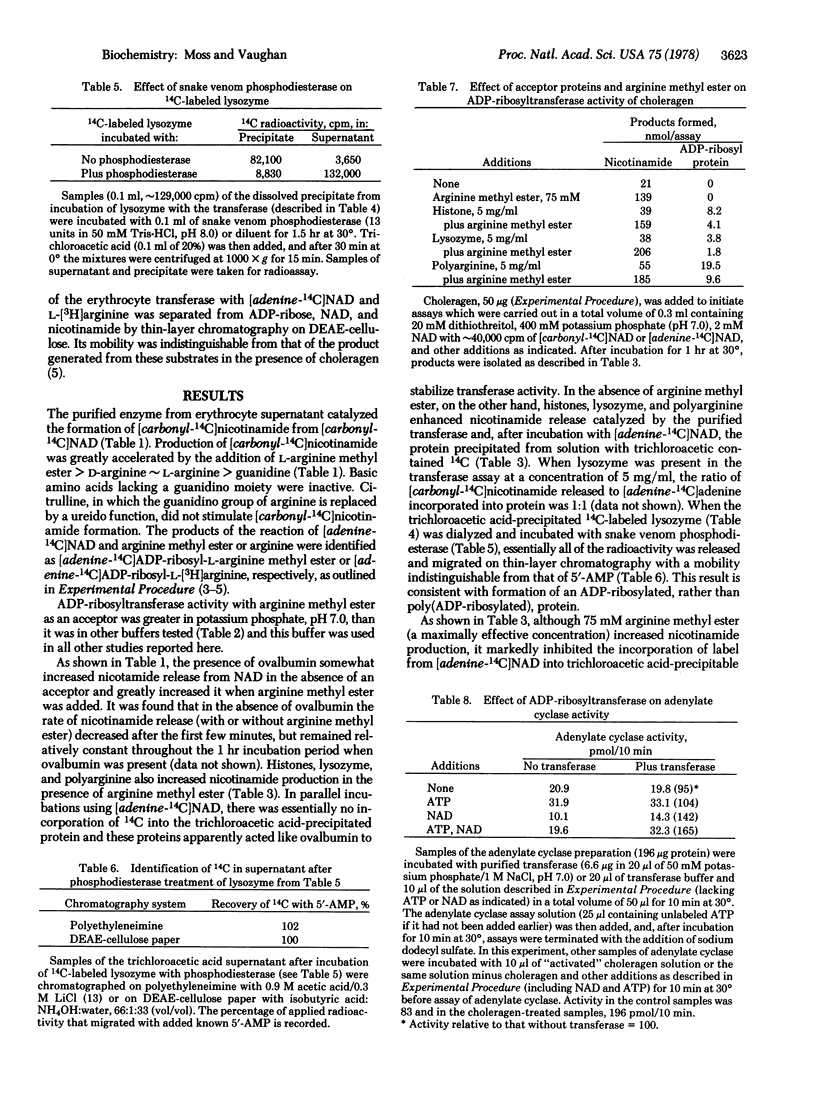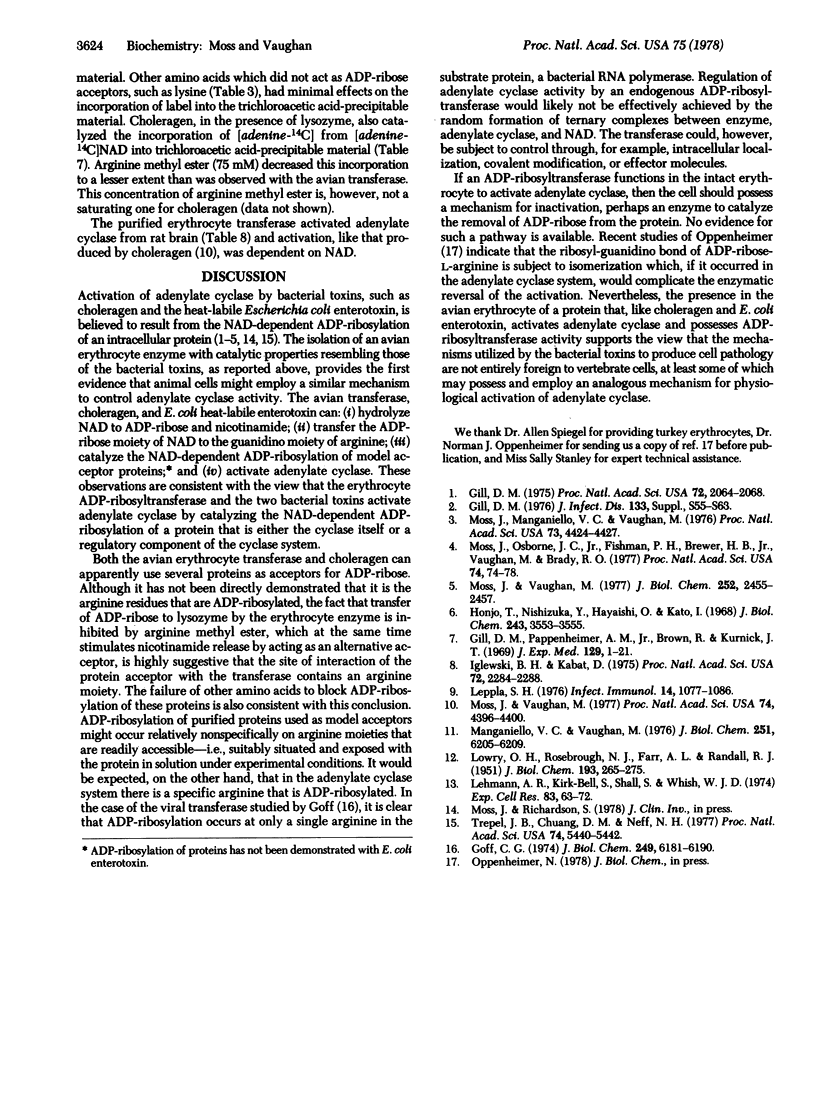Abstract
An ADP-ribosyltransferase was purified ∼500-fold from the supernatant fraction of turkey erythrocytes. The enzyme hydrolyzed [carbonyl-14C]NAD to ADP-ribose and [carbonyl-14C]nicotinamide at a low rate. Nicotinamide formation from NAD was enhanced by arginine methyl ester > D-arginine ∼ L-arginine > guanidine; lysine, histidine, and citrulline were ineffective. Incubation of [adenine-U-14C]NAD and arginine methyl ester or arginine with the purified enzyme resulted in the formation of new compounds that contained 14C, reacted with ninhydrin, and quenched background fluorescence of thin-layer plates viewed in ultraviolet light. Their mobilities on thin-layer chromatograms were indistinguishable from those of ADP-ribosylarginine methyl ester and ADP-ribosylarginine formed during incubation of choleragen with NAD and arginine methyl ester or arginine, respectively [Moss, J. & Vaughan, M. (1977) J. Biol. Chem. 252, 2455-2457]. The purified transferase also catalyzed the incorporation of label from [adenine-14C]-NAD into lysozyme, histones and polyarginine. When the 14C-labeled lysozyme was incubated with snake venom phosphodiesterase, the radioactivity was released and, on thin-layer chromatograms, exhibited a mobility indistinguishable from that of 5′-AMP, as would be expected of an ADP-ribosylated protein, but not of a poly(ADP-ribosylated) product. The purified transferase activated rat brain adenylate cyclase and, as is the case with choleragen, activation was absolutely dependent on NAD. The presence in the avian erythrocyte of a protein that, like choleragen and Escherichia coli heat-labile enterotoxin, apparently activates adenylate cyclase and possesses ADP-ribosyl transferase activity is consistent with the view that the mechanisms through which the bacterial toxins produce pathology are not entirely foreign to vertebrate cells, at least some of which may possess and employ an analogous mechanism for activation of adenylate cyclase.
Keywords: NAD, choleragen, Escherichia coli heat-labile enterotoxin
Full text
PDF



Selected References
These references are in PubMed. This may not be the complete list of references from this article.
- Gill D. M. Involvement of nicotinamide adenine dinucleotide in the action of cholera toxin in vitro. Proc Natl Acad Sci U S A. 1975 Jun;72(6):2064–2068. doi: 10.1073/pnas.72.6.2064. [DOI] [PMC free article] [PubMed] [Google Scholar]
- Gill D. M., Pappenheimer A. M., Jr, Brown R., Kurnick J. T. Studies on the mode of action of diphtheria toxin. VII. Toxin-stimulated hydrolysis of nicotinamide adenine dinucleotide in mammalian cell extracts. J Exp Med. 1969 Jan 1;129(1):1–21. doi: 10.1084/jem.129.1.1. [DOI] [PMC free article] [PubMed] [Google Scholar]
- Goff C. G. Chemical structure of a modification of the Escherichia coli ribonucleic acid polymerase alpha polypeptides induced by bacteriophage T4 infection. J Biol Chem. 1974 Oct 10;249(19):6181–6190. [PubMed] [Google Scholar]
- Honjo T., Nishizuka Y., Hayaishi O. Diphtheria toxin-dependent adenosine diphosphate ribosylation of aminoacyl transferase II and inhibition of protein synthesis. J Biol Chem. 1968 Jun 25;243(12):3553–3555. [PubMed] [Google Scholar]
- Iglewski B. H., Kabat D. NAD-dependent inhibition of protein synthesis by Pseudomonas aeruginosa toxin,. Proc Natl Acad Sci U S A. 1975 Jun;72(6):2284–2288. doi: 10.1073/pnas.72.6.2284. [DOI] [PMC free article] [PubMed] [Google Scholar]
- LOWRY O. H., ROSEBROUGH N. J., FARR A. L., RANDALL R. J. Protein measurement with the Folin phenol reagent. J Biol Chem. 1951 Nov;193(1):265–275. [PubMed] [Google Scholar]
- Lehmann A. R., Kirk-Bell S., Shall S., Whish W. J. The relationship between cell growth, macromolecular synthesis and poly ADP-ribose polymerase in lymphoid cells. Exp Cell Res. 1974 Jan;83(1):63–72. doi: 10.1016/0014-4827(74)90688-0. [DOI] [PubMed] [Google Scholar]
- Leppla S. H. Large-scale purification and characterization of the exotoxin of Pseudomonas aeruginosa. Infect Immun. 1976 Oct;14(4):1077–1086. doi: 10.1128/iai.14.4.1077-1086.1976. [DOI] [PMC free article] [PubMed] [Google Scholar]
- Manganiello V. C., Vaughan M. Activation and inhibition of fat cell adenylate cyclase by fluoride. J Biol Chem. 1976 Oct 25;251(20):6205–6209. [PubMed] [Google Scholar]
- Moss J., Manganiello V. C., Vaughan M. Hydrolysis of nicotinamide adenine dinucleotide by choleragen and its A protomer: possible role in the activation of adenylate cyclase. Proc Natl Acad Sci U S A. 1976 Dec;73(12):4424–4427. doi: 10.1073/pnas.73.12.4424. [DOI] [PMC free article] [PubMed] [Google Scholar]
- Moss J., Osborne J. C., Jr, Fishman P. H., Brewer H. B., Jr, Vaughan M., Brady R. O. Effect of gangliosides and substrate analogues on the hydrolysis of nicotinamide adenine dinucleotide by choleragen. Proc Natl Acad Sci U S A. 1977 Jan;74(1):74–78. doi: 10.1073/pnas.74.1.74. [DOI] [PMC free article] [PubMed] [Google Scholar]
- Moss J., Vaughan M. Choleragen activation of solubilized adenylate cyclase: requirement for GTP and protein activator for demonstration of enzymatic activity. Proc Natl Acad Sci U S A. 1977 Oct;74(10):4396–4400. doi: 10.1073/pnas.74.10.4396. [DOI] [PMC free article] [PubMed] [Google Scholar]
- Moss J., Vaughan M. Mechanism of action of choleragen. Evidence for ADP-ribosyltransferase activity with arginine as an acceptor. J Biol Chem. 1977 Apr 10;252(7):2455–2457. [PubMed] [Google Scholar]
- Trepel J. B., Chuang D. M., Neff N. H. Transfer of ADP-ribose from NAD to choleragen: a subunit acts as catalyst and acceptor protein. Proc Natl Acad Sci U S A. 1977 Dec;74(12):5440–5442. doi: 10.1073/pnas.74.12.5440. [DOI] [PMC free article] [PubMed] [Google Scholar]


